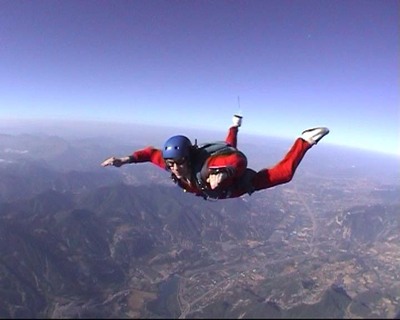When skydiving, there are multiple different positions that you can do. The two positions that I am going to talk about are free flying and tracking. First I am going to start with free flying. Free flying is when you are falling in a position that is different from the normal skydiving position, which is falling on your belly. When you are free flying, you could be falling in a sitting position, a position on your back, a standing position, or a diving head first position. Free flying is recognized as one of the hardest forms of flying. When you are belly flying, you are falling at about 120 miles per hour, which is terminal velocity. When you are free flying, there is less surface area for the air to push up against, which causes you to fall closer to 160 to 200 miles per hour; but, because the parachute is designed to open at 120 miles per hour, someone that is free flying must go onto their belly to slow down to 120 mph so he can deploy his parachute. When I bunch of people are free flying or belly flying close together, they need to be able to spread out before deploying their parachutes; so the different people's parachutes do not get tangled. These people falling together use tracking to get away from one another. Tracking is an altered form of belly flying which allows the skydiver to have forward movement. In a normal skydiving position you arch at the hips, have your arms bent at a 90 degree angle, have the upper thigh straight with a 45 degree bend your knees, and your toes pointed.

This is an example of the standard skydiving position.
In tracking you try to be as straight as possible. You have your whole body straight with your arms by your side.

This is an example of tracking.
Awesome Free Flying
In this video there is free flying from the beginning to about four minutes into the video and from the seven minute mark to about the ten minute mark. At the 3:20 minute mark, when the skydiving straighten their body, they are tracking to try to separate themselves from the others.
 This is an example of the standard skydiving position.
This is an example of the standard skydiving position. This is an example of tracking.
This is an example of tracking.
No comments:
Post a Comment